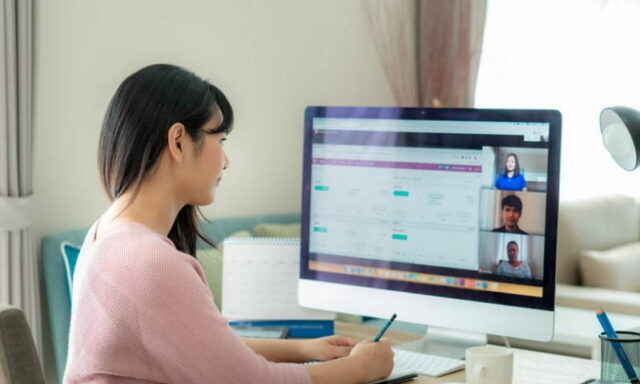The rapid onset of the COVID-19 pandemic changed the way that businesses operate – and many of the changes are likely to have changed the Dutch labour market for good. With social distancing in place, offices closed and staff working from home, the face of the workplace changed practically overnight. What we now understand about the virus and how it spreads means we’ll need to make changes to our workplaces, so that we can welcome employees back again safely.
As we learn to navigate the new normal, businesses will understandably be delaying large-scale office renovations until we know how regulations could look. Instead, short-term fixes will be the priority for keeping employees safe as we slowly return to office life. Managers should work together with their staff, providing a platform to share their thoughts on these short-term solutions, as this could form the basis for the future offices they will be working from.
We’ve compiled useful best practices as we ease back to normality in a safe way, providing actionable information for business owners, team managers and employees themselves.
Open offices and co-working spaces
Open-plan offices and co-working spaces have grown increasingly popular in the last decade. By nature, these office spaces encourage interactions between people, something we’ve been moving away from in light of the pandemic. In order to minimise the risk of excessive contact, simple measures that offices could implement include:
- Ensuring desks and workstations are 1.5 meters apart
-
Taping or marking entry, exit and circulation routes around the office, to control the flow of people
-
Installing clear plastic screens in collaborative or client-facing areas, to provide safety barriers during conversation which still allowing for interpersonal communication
-
Installing sanitising gel dispensers around the building that employees can easily access – at doorways and in the bathrooms, for example
-
Encouraging conscientious hygiene practices among employees
-
Assigning workstations to particular employees – or encouraging them to bring in and use their own devices – to minimise the sharing of surfaces such as keyboards
-
Providing employees with face masks if they commute by public transport
One option that may be put forward by employees and management alike is a return to individual office cubicles. But given collaboration and communication are enhanced through open spaces, solutions that maintain this openness in a safe way are likely to be favoured. It goes without saying that individual preferences will vary across businesses and workers alike, and this must be taken into consideration when planning more permanent changes to the workplace.
Looking to the future, the pandemic has sparked discussions of a more futuristic and less manual workplace. Rather than having multiple people touching buttons and switches for entry barriers, lifts, coffee machines, lights and remote-controlled air conditioning or heating units, businesses are likely to prioritise fully contactless systems.
Smart office solutions prioritising the quality and cleanliness of the air within the workplace will become a priority, perhaps even incorporating ultraviolet light into air filtering systems. The workplaces of the future will be materially different, too, with surfaces made from substances that can withstand heavy-duty – and possibly hospital-grade – cleaning.
Bringing in all-new air filtering systems and refitting outdated workplaces with surfaces more in keeping with the post-pandemic reality will, of course, come at a substantial financial cost, so it’s likely that these long-term changes will be introduced in the mid-term – rather than near-term.
For now, it’s in employers’ best interests to prioritise both physical and mental well-being in their workplace with reassuring, temporary practical measures.
Are you looking to scale up your team with permanent or temporary employees?
Office rotations and staggered starting times
As employees start migrating back to the office from their homes, an increase in shift-style office timetables will help ensure we uphold social distancing in the workplace. By reducing the number of staff in the office at any one time, businesses will be able to mitigate the risk of the virus continuing to spread among their workforce.
More flexible shifts will also allow workers to avoid travelling at peak times on public transport, further reducing their exposure to potential infection. This measure will also ease the burden on these essential public services so that they can safely cater to those who need them most.
Where possible, office managers may want to split their employees into groups, with different assigned entrances and exits to the office building. This will minimise contact between different shift groups as they enter and exit the building, ensuring interaction between them is kept to an absolute minimum.
Beyond the health benefits these measures would have, they also serve to set employees’ minds at ease, and make them feel excited – rather than apprehensive – about returning to the office.
Working from home
COVID-19 has unquestionably caused a shake-up in how we approach business. Forced adaptation to working from home has proven that in-person meetings, interviews, appraisals and creative or strategy-based sessions can – if needed – take place online.
Many employees will have become so comfortable with working from home that they will be unwilling to abandon the habit entirely. For some, working mainly from a home office will actually improve their overall well-being and simultaneously increase their overall productivity. At the same time, many of your employees will be keen to get back to the more sociable, communication-enabling environment of the office, as it’s where they feel able to produce their best work. The sense of community that comes from being based in an office can often be integral to a company’s ethos, even underpinning many employees’ loyalty to the organisation. After all, it’s difficult to replicate office culture and Friday drinks via Zoom!
If anything, these past few months have emphasised the need for adaptability in the modern workplace, and that’s something businesses need to take with them as they move forward: recognising different employees’ needs for different working environments will unleash their potential to consistently achieve more. It might also help businesses to retain their employees: a Gallup survey showed that 54% of US workers would leave their job for one that allowed them to work more flexibly. That number may well have increased over recent months, as many more employees have had the opportunity to try working remotely.
Employers will also need to recognise that many workers may still have increased care responsibilities as they start returning to work. As changes are made to schools and childcare centres, and even perhaps care homes and hospitals, the ‘new normal’ will likely include shifts in our commitments to the youngest and oldest members of our families and wider communities. Responsible, insightful employers will ensure they take these additional roles into account when recognising their employees’ needs for ongoing flexibility.
Managing teams remotely
Consistent, empathetic communication is vital to successfully managing remote teams. Clarity about the situation that your team and company is facing is hugely important, as honesty is key to maintaining a trusting relationship between your business and its workforce.
Team managers are the closest touchpoints to employees and, with ongoing remote work, it’s key that they’re prepared to perform an open, supportive and communicative role. Often, managers will need to address remote workers’ practical concerns, such as providing secure access to internal files and scheduling meetings at times that work around ongoing childcare responsibilities. But, simultaneously, they should be aware of employees’ general well-being and their ability to cope with the ongoing anxieties of the pandemic.
Even in the post-pandemic reality, managers should still be prepared to offer advice and support when needed.
Managers will need to adapt to the idea that members of their team will want to perform a blend of in-person and remote tasks. By splitting their working hours between a home office and a communal office space, employees can collaborate face-to-face on specific tasks and prioritise their personal space for others. Even the nature of hours worked in person is likely to change: smaller-scale office hotspots could replace larger, central headquarters to limit workers’ need to travel and reduce overall exposure to large groups of people.
Businesses looking to benefit fully from this new, more agile way of working may want to roll right back to the basics: is there still the same need for the traditional in-person, full-time style? As digital communications become increasingly expected, your company’s new, improved and agile post-COVID approach may be more open to fully remote, freelance and part-time contracts. Expanding your business horizons and talent pool online could be a vital asset to your future business strategy.
Communication with clients
Just as it’s important for employers to maintain open contact with employees during this time, communication with clients is also key. Securing your reputation as a responsible workplace is fundamental: clients will want to see that businesses are taking measures to proactively protect their staff, as well as the company’s business interests.
Now is the time to update and reinforce your business commitment to individual safety and to society as a whole, proving to your client base that you’re a workplace fit for the future.
Communication with clients has, of course, also turned remote. This has certainly brought its challenges. It can be more difficult to deliver a convincing pitch, or discuss sensitive business arrangements, using digital communication tools, for a wide range of reasons. Yet, the fact that digital communications is now a standard approach opens up new workplace opportunities, too. Why not connect with clients on the other side of the world, now that in-person meetings are no longer a necessity? Why not expand your workplace network and investment into new areas, in preparation for a profitable future?
Changes in our ability to meet clients face-to-face have also had a marked effect on the environment. The pandemic has allowed us – and the Earth – a moment to breathe. Under lockdown, we haven’t been driving or flying, and cities across the world are noticing the benefits of this reduction in pollution. Looking to the future, as forward-thinking businesses seek to ‘green’ their activities, many will reconsider the need to fly internationally for half-day meetings or one-hour pitches. Time, money and emissions can be saved by using the digital tools at our disposal.
The new workplaces of the post-pandemic reality
A sense of connection, community and teamwork is key to many aspects of business. Brands and companies, as well as creativity, collaboration and innovation, can sometimes depend on them. But, it’s vital to remember that the more spacious, flexible and unconstrained workplaces of the future have huge potential, too. They may well give your employees the freedom they need to bring even greater inspiration to their day-to-day work.
Looking to the workplaces of the future is not about abandoning office communities altogether.
Instead, it’s about adapting them to a ‘new normal’ that is safe, hygienic, informed and modernised. Adjusting our old, familiar workplaces needs to be an ongoing evolution, beyond a quick fix. As businesses continue to take in scientific data on the COVID-19 virus, government advice, business sector regulations and feedback from their own employees, blueprints for the workplaces of the future will steadily take shape.
From a time of crisis comes an opportunity for reinvention. Short-term, easily implemented solutions to ensure employees’ physical well-being and peace of mind are a great first step to gradually welcoming them back to the workplace. Longer-term solutions will come in time, as executives, managers and workers rally together to create the workplaces of the future.
Do you need flexible workers for a limited time period? Let’s have a chat about how we can help your company!
Are you looking to scale up your team with permanent or temporary employees?






